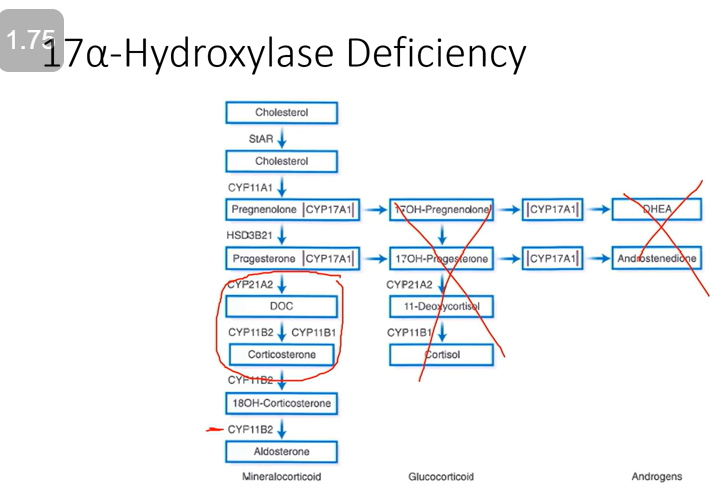16-Adrenal Glands
1/43
There's no tags or description
Looks like no tags are added yet.
Name | Mastery | Learn | Test | Matching | Spaced |
|---|
No study sessions yet.
44 Terms
Adrenal Glands
These are located in the retroperitoneal cavity above each kidney and the hormone secretions are essential for life
The adrenal cortex and adrenal medulla are two separate glands that have different origins
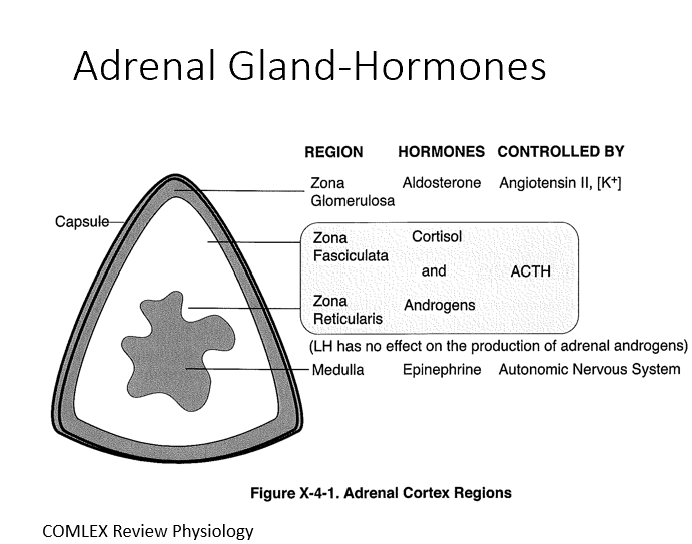
Adrenal Cortex
Mesodermal origin with three distinct layers (80% of tissue)
3 Layers:
Zona Glomerulosa (Aldosterone by ANG II)
Zona Fasciculata (Cortisol by ACTH)
Zona Reticularis (Androgens by ACTH)
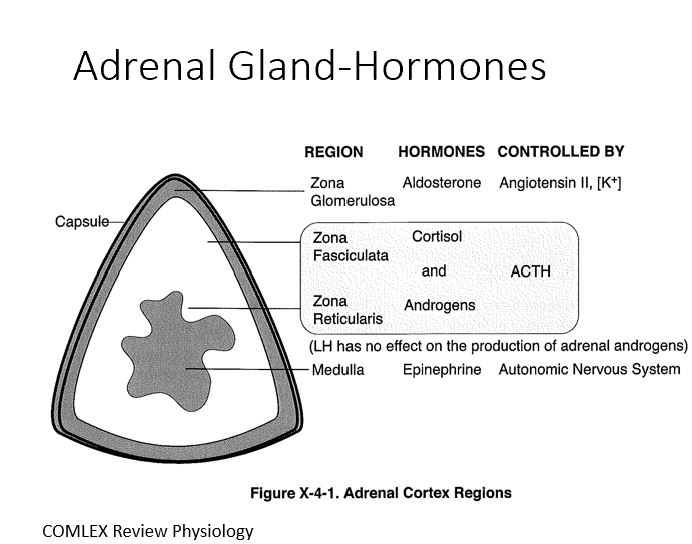
Adrenal Medulla
Neuroectodermal origin and represents 20% of the tissue
Makes Epi by ANS (sometimes NE too)

Blood Supply for Adrenal Glands
Superior, middle, and inferior suprarenal arteries
Branches from the arteries form a network of capillaries that flow from the adrenal cortex to the medulla
Directionality in blood flow results in a high concentration of steroid hormones being delivered to the adrenal medulla
Cortisol influences the biosynthetic pathway of catecholamines
Venous Drainage Adrenal Glands
Venous drainage is via a single renal vein on each side (right→inferior vena cava and left→left renal artery)
Synthesis of Catecholamines (based on, controlled by, released by)
Based on a tyrosine derivative!
Under control of the CRH-ACTH-cortisol axis
ACTH stimulates synthesis of DOPA
Cortisol increases PNMT (upregulates NE→Epi)
Release is triggered by ANS control
Neurons and Adrenal Medulla
Synthesis of catecholamines happening in these 2 locations:
Norepinephrine and Epinephrine
THESE are Synthesized in Different Cellular Compartments
NE in chromatin granules
Once in cytosol, PMNT can act on NE to make Epi!
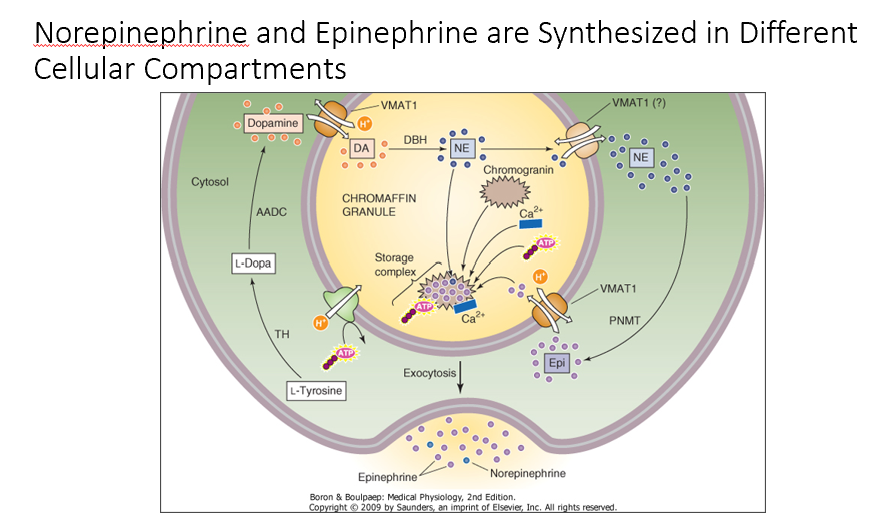
Catecholamine Receptors
Adrenergic receptors
Types:
Alpha 1
Alpha 2
Beta 1
Beta 2
Beta 3
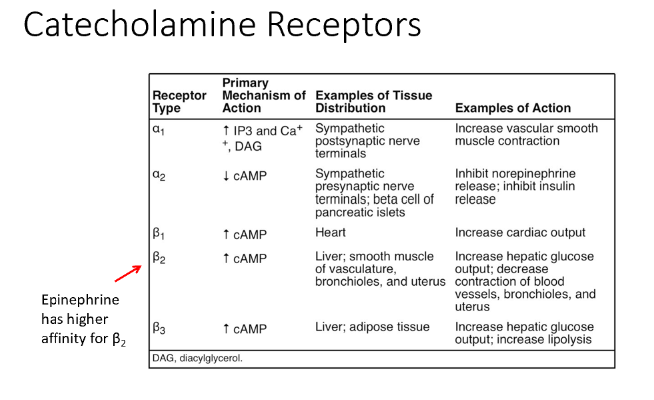
Alpha 1 Receptor
Tissue Distribution: Sympathetic postsynaptic nerve terminals
Action: Increase vascular smooth muscle contraction
Alpha 2 Receptor
Tissue Distribution: Sympathetic presynaptic nerve terminals; beta cells of pancreatic islets
Action: Inhibit norepinephrine release; inhibit insulin release
Beta 1 Receptor
Tissue Distribution: Heart
Action: Increase cardiac output
Beta 2 Receptor
Tissue Distribution: Liver; smooth muscle of vasculature, bronchioles, and uterus
Action: Increase hepatic glucose output; decrease contraction of blood vessels, bronchioles, and uterus
EPI has a higher affinity for this!
Integrated Catecholamine Response to Exercise
Increased CO, venous return, & blood flow to skel muscle
Alpha receptors simultaneously decrease blood flow to GI
Bronchioles (via Beta 2 receptors) dilate!
Increases exchange of O2 and CO2
Overall, Catecholamines stimulate increase in blood glucose and mobilization of other energy stores (increasing nutrient supply to mm.)
lipolysis
gluconeogenesis
ketogenesis
decreasing glucose uptake
Beta Cells- decrease in insulin secretion
Alpha Cells- increase in glucagon secretion
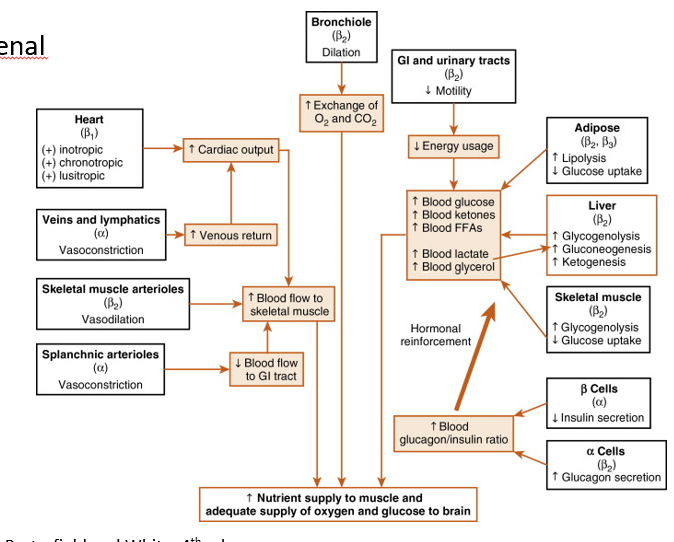
Degradation of Catecholamines
They’re only active for 10 seconds
Degradation happens via 2 enzymes:
COMT: catecholamine-O-methyltransferase
MAO: monoamine oxidase
At the end of degradation of NE/Epi, we see Metanephrine 7 Vanillymandelic Acid (found in urine).

Determining total catecholamine production
Catecholamines, metanephrines, and
vanillylmandelic acid (VMA) can be measured
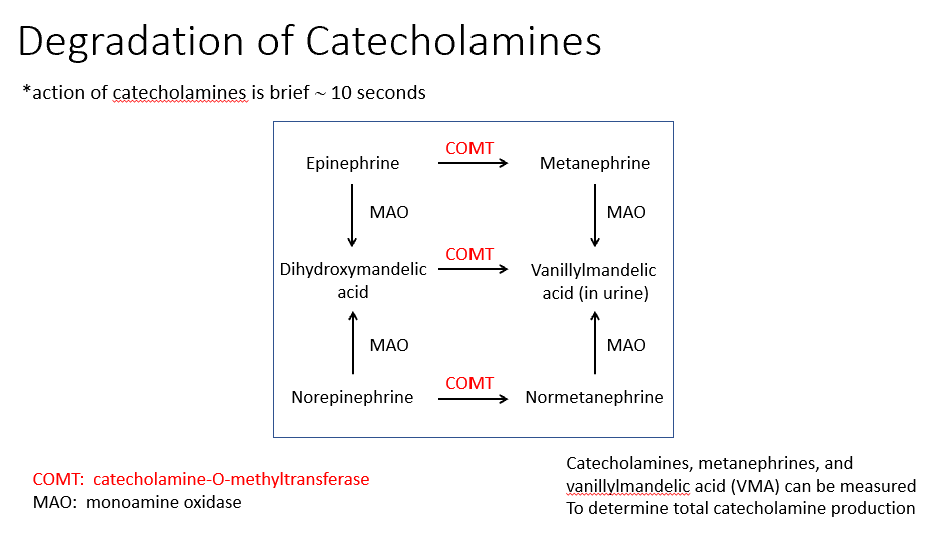
Pheochromocytoma
Tumor of chromaffin tissue
Produces excess catecholamines
Symptoms sporadic
Headaches
Sweating
Palpitations
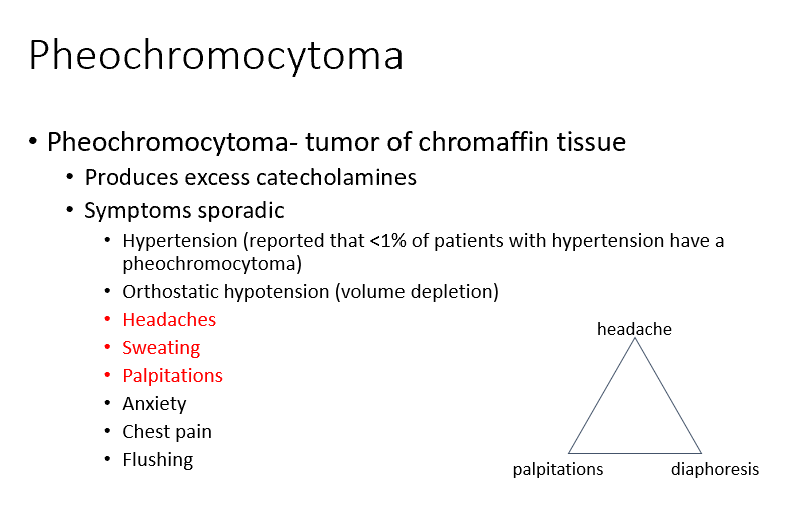
Adrenal Cortex Hormones
Aldosterone
Cortisol
Androgens
Aldosterone
(mineralocorticoid- regulates salt and water retention)
Functions in salt and water homeostasis
Cortisol
(glucocorticoid- increases plasma glucose)
Released in response to stress
Influences glucose utilization, immune and inflammatory homeostasis
Androgens
dehydroepiandrosterone (DHEA)
Primary androgenic hormone in females
Biosynthetic Pathway for Adrenal Hormones: Enzymes
We start out with cholesterol and then numerous enzymes are involved in taking that cholesterol and turning it into adrenal hormones:
17-Alpha Hydroxylase
21-Alpha Hydroxylase
11-Beta Hydroxylase
Aldosterone Synthase
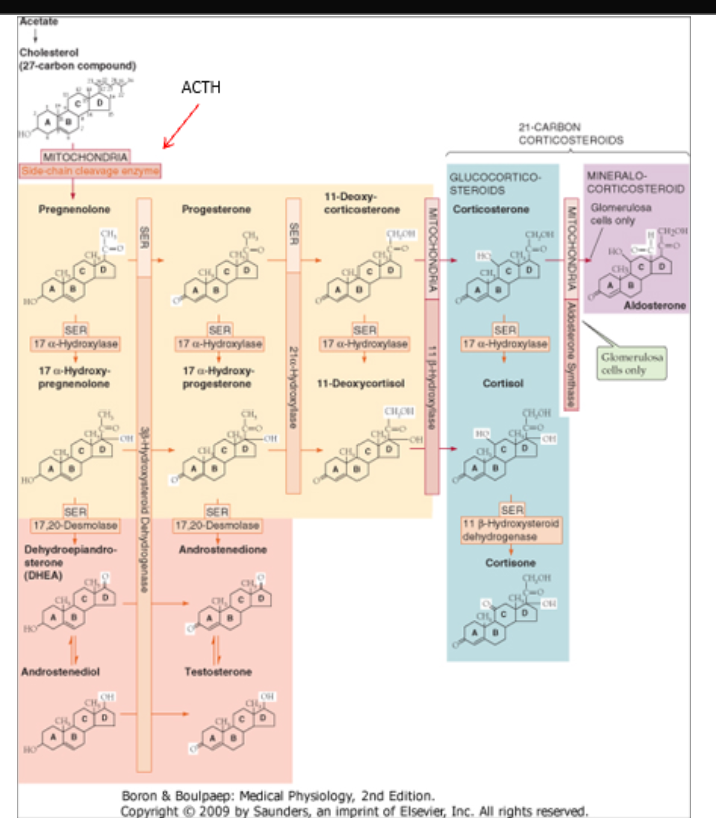
Cholesterol
What all adrenal hormones are derivatives of
That Zone
Each zone of the adrenal cortex contains a specific set of enzymes that controls hormone production for _.
Aldosterone
Converts glucocorticoids into mineralocorticoids in the biosynthetic pathway.
Gluc and Mineral corticoids can have overlapping activity on the receptors of each particular hormone.
Thus, our body has put only Gluc or Mineral corticoid receptors in specific areas so it only receives the one it’s supposed to.
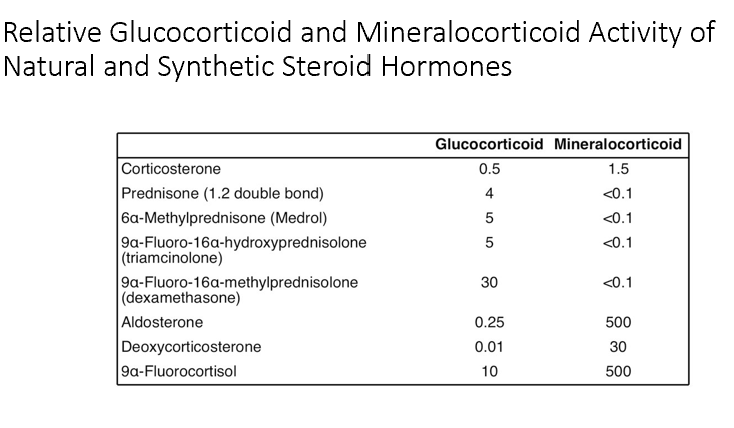
Cortisol (what is it, stimulating factors, inhibiting factors, pathway)
Hormone from the adrenal cortex:
Stimulatory Factors:
Stress
Sleep-wake transition
Decreased blood cortisol levels
Inhibitory Factors:
Increased blood cortisol levels (it inhibits itself)
Somatostatin
Pathway:
Stress helps regulate CRH from hypothalamus
CRH stimulates ACTH production in pituitary gland
When ACTH is release, it can work on adrenal cortex to induce synthesis of glucocorticoids/cortisol
Cortisol feedback loops:
Negative- inhibits ACTH & CRH
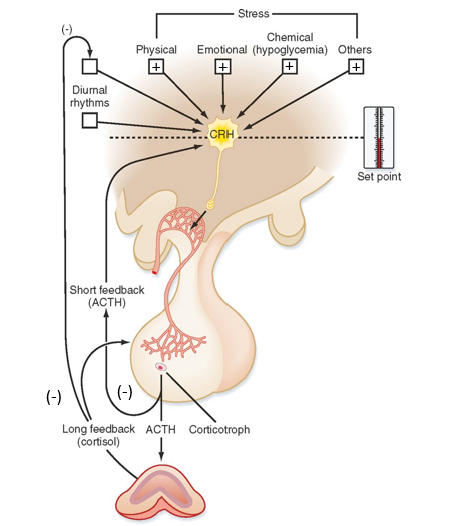
Actions of Cortisol
Increases gluconeogenesis, protein catabolism, lipolysis, and decreases glucose utilization and insulin sensitivity
Anti-inflammatory effects
Suppresses immune responses
T cell suppression (IL-2)
Lyses eosinophils
Maintain vascular responsiveness to catecholamines
Maintains normal blood pressure
↓ cortisol → hypotension
Inhibition of bone formation
Decreases type I collagen
Decreases osteoblast activity
Decreases gut Ca2+ absorption
Increases glomerular filtration rate (GFR)
Decreases REM sleep (psychosis)
Acute Release of Cortisol
Cortisol Increases
Insulin/Glucagon Ratio Decreases
Epi and NE Increases
Using our energy stores, increase in glucose production
Metabolic response to stress ensures there’s enough energy to meet increased demands (aka enough glucose for brain).
Cortisol is increasing energy
Cortisol is limiting immune response to stress
Chronic Release of Cortisol
Cortisol Increased
Insulin/Glucagon Ratio Increased
Epi & NE Decreased
Increased appetite, increased glycogen synthesis, increased protein synthesis, decreased GLUT-4 glucose intake (Cortisol is antagonizing insulin)! Decreased lipolysis and increased TAG synthesis.
Metabolic responses: localized obesity & muscle weakening. Decreased glucose uptake due to cortisol antagonizing insulin. See both hyperglycemia and hyperinsulinemia.
Steroid Cushing Syndrome
overreplacing glucocorticoids/cortisol to treat their chronic inflammatory condition → Cushing Syndrome (too much cortisol) and Adrenal Atrophy (body isn’t making its own anymore)
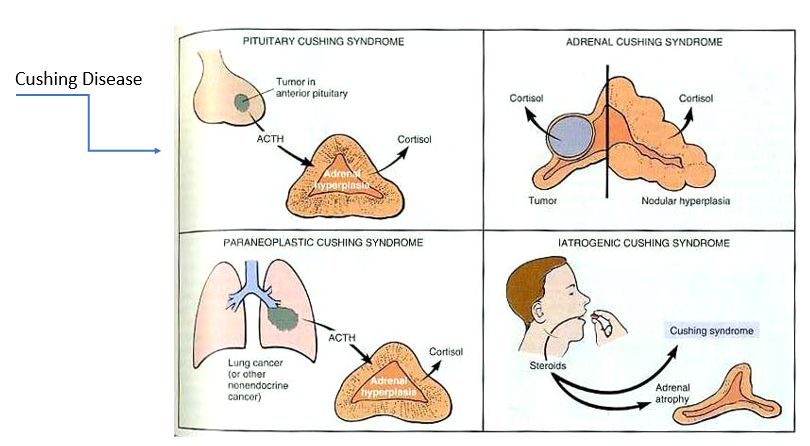
Cushing Disease
Tumor in anterior pituitary (overproducing ACTH) → too much cortisol → adrenal hyperplasia
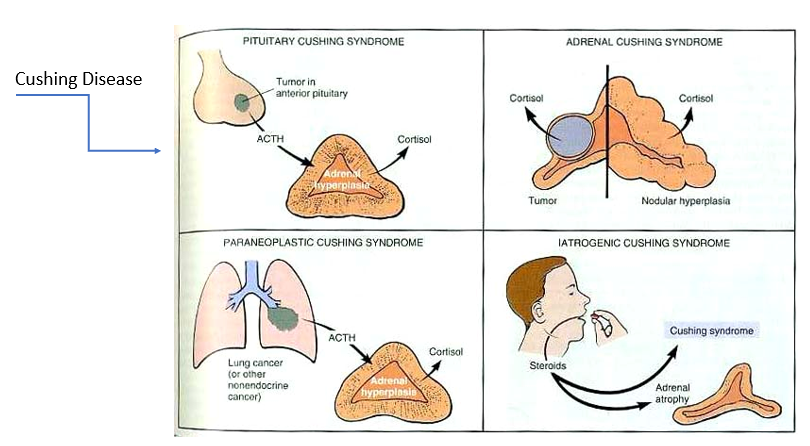
Adrenal Cushing Syndrome
Tumor in adrenal cortex or nodular hyperplasia → too much cortisol
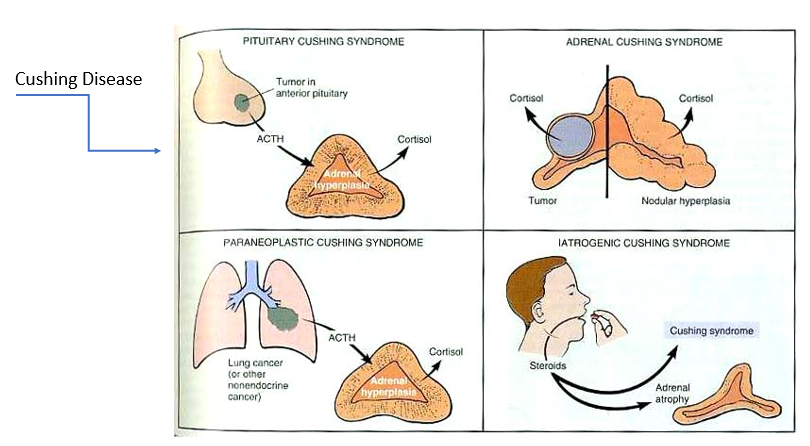
Paraneoplastic syndrome
tumor in location other than anterior pituitary that’s overproducing ACTH → too much cortisol
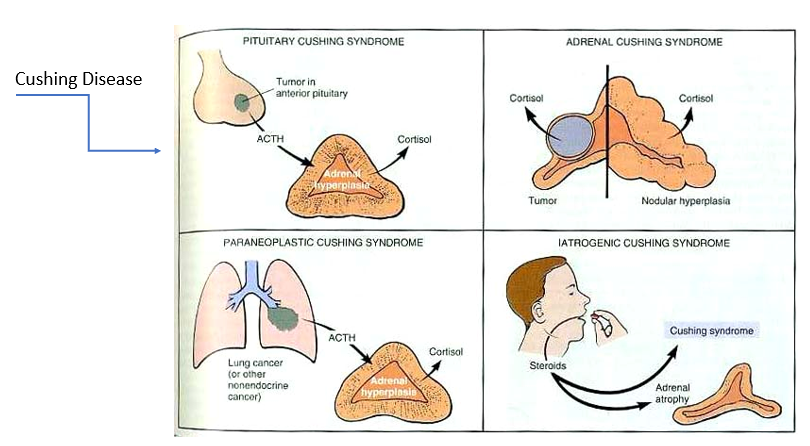
Why do we see Adrenal Atrophy in the Presence of Exogenous Glucocorticoids?
Normal:
Hypothalamus → CRH → Pituitary → ACTH → Zona Fasciculata → Cortisol
Too many exogenous glucocorticoids:
Too much corticosteroid present → feeds back to inhibit CRH from hypothalamus & ACTH from pituitary
No stimulation of hypothalamus & pituitary = no hormones produced (CRH and ACTH) = Zona Fasciculata atrophies
This is why we have taper doses of steroids, to allow adrenal gland to build back up and make its own again!
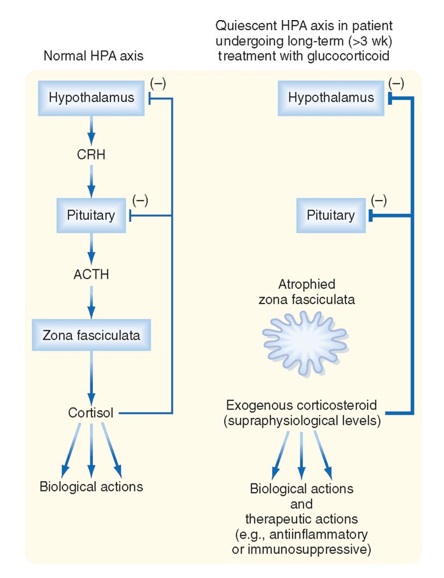
Aldosterone
Renin-Angiotensin (Major Regulatory Pathway)
Liver: Angiotensinogen
Kidney: Renin production
Pathway
Angiotensinogen (Liver) → via Renin (in kidney)→ Angiotensin I (ANGI) → via ACE (in lung)→ Angiotensin II (ANGII)
ANGII
Triggers aldosterone synthesis by acting on adrenal cortex
Aldosterone then works on our kidneys to decrease Na/Water excretion (but increases K secretion)
Renin Expression
Induced by decreased blood pressure (lower blood volume)
When BP increases (thanks to aldosterone), it shuts renin down!
Note: High K levels will promote synthesis of aldosterone & decrease K retention!
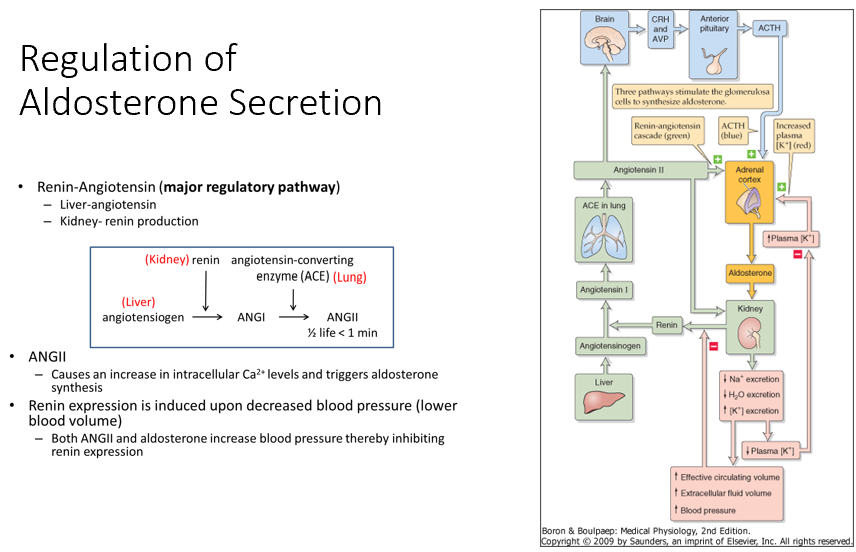
Actions of Aldosterone (what it controls, vs ADH, receptors, lack, excess)
Controls Na+ resorption in the extracellular space
Increases Na+ resorption, increases K+ and H+ secretion
Contrast THIS to ADH which regulates water balance and hence plasma osmolality
ADH doesn’t impact Na absorption, THIS does
Receptors
Kidney- target cells have 11β-HSD2 (11B-hydroxysteroid dehydrogenase II) that converts cortisol to cortisone which has low affinity for the mineralocorticoid receptor (MR)
Colon
Salivary glands
Sweat glands
Lack of aldosterone
Hyperkalemia, hypotension, metabolic acidosis
Excess aldosterone
Hypokalemia, hypertension, metabolic alkalosis
Interconversion of Cortisol to Cortisone
11β-hydroxysteroid dehydrogenase type II is for mineralocorticoid cells (Cortisol → Cortisone)
11β-hydroxysteroid dehydrogenase type I is for glucocorticoid cells (Cortisone → Cortisol)
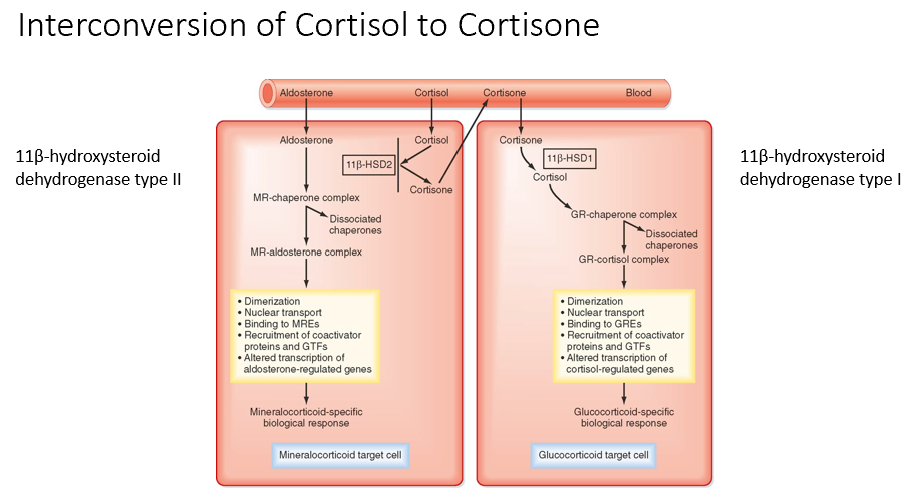
Primary Hyperaldosteronism (causes & what happens)
Most common cause:
Idiopathic (generalized increase in the zona glomerulus)
Second most common cause:
Adenoma in adrenal cortex
What happens:
too much aldosterone
Na is reabsorbed, water follows (develops HTN)
K is excreted (hypokalemia)
H loss (metabolic alkalosis)
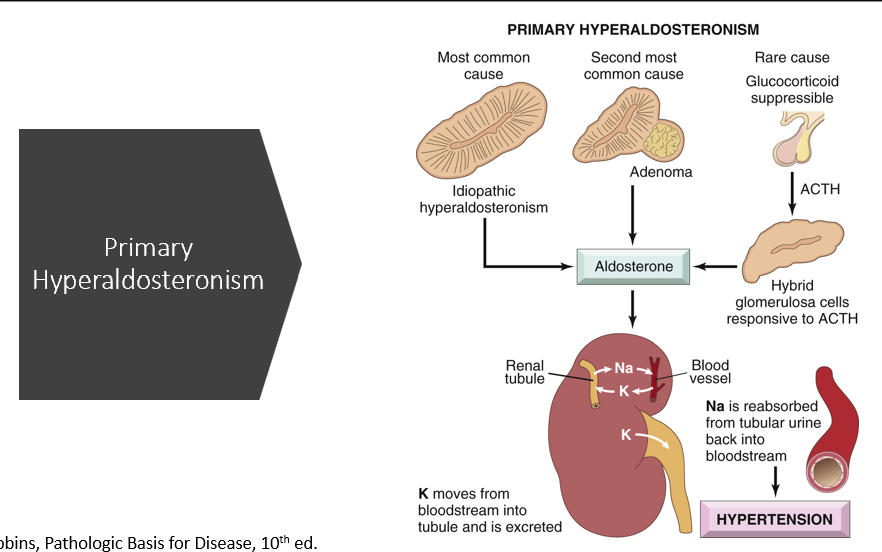
Actions of Adrenal Androgens
Females
Presence of pubic and axillary hair, libido
In females the only primary of androgens is from the adrenal cortex
Males
Same as testosterone
Men do not need adrenal androgens as they are synthesized in the testes
Adrenal Pathophysiology
Cortisol:
Excess = Cushing's syndrome
Deficiency = Addison's disease and hypocortisolism
Aldosterone:
Excess = Hyperaldosteronism (Conn's syndrome)
Deficiency = Addison's disease and hypoadrenalism.
Sex steroids:
Excess = Hirsutism or virilization.
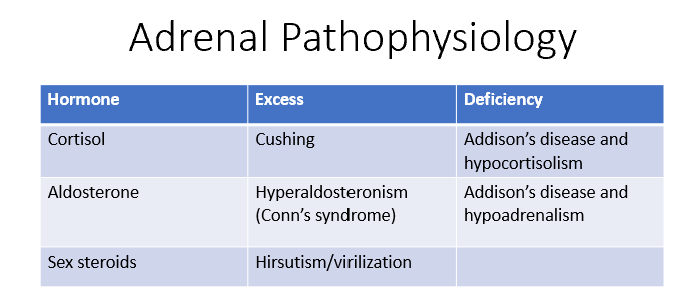
Congenital Adrenal Hyperplasia
A group of autosomal recessive disorders that involve a deficiency in either cortisol, aldosterone, or both due to impaired synthesis.
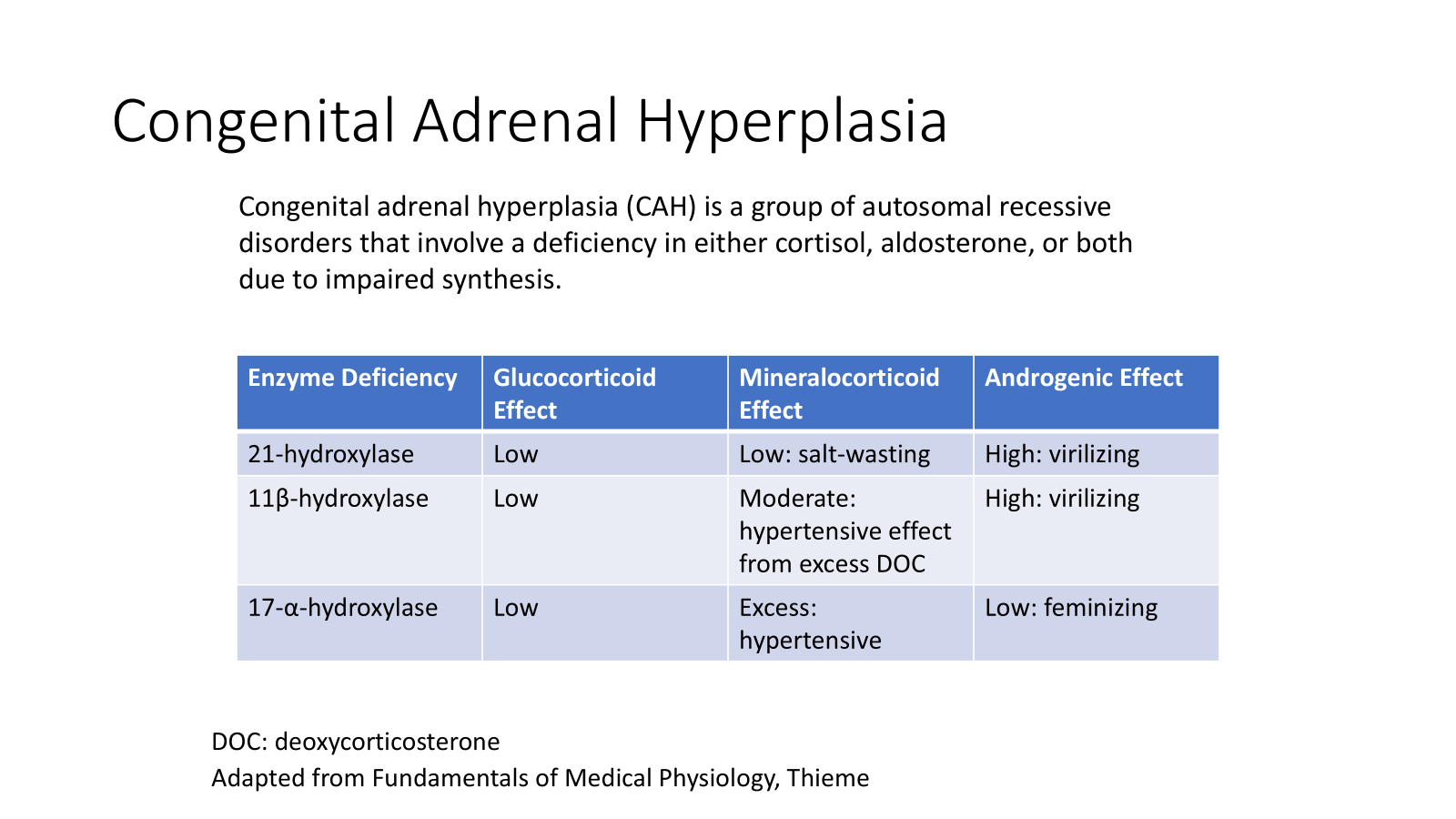
Enzyme Deficiency: 21-hydroxylase
Glucocorticoid Effect: Low
Mineralocorticoid Effect: Low; salt-wasting
Androgenic Effect: High; virilizing
Buildup of precursors but we DON’T get cortisol or any other corticosteroids. We’re left with excess androgens.
Caused by:
Mutation in CYP21A2 gene!
Can have total loss or partial loss
Total loss:
Salt-wasting
Hyponatremia
Hyperkalemia
Hypotension
Cardiovascular collapse and possibly death
Virilization- recognizable in females at birth but more difficult in males
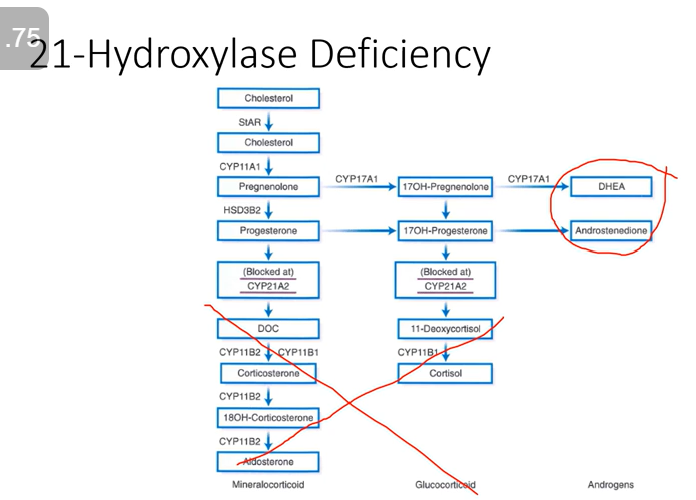
Enzyme Deficiency: 11β-hydroxylase
Glucocorticoid Effect: Low
Mineralocorticoid Effect: Moderate; hypertensive effect from excess deoxycorticosterone (DOC)
Androgenic Effect: High; virilizing
We lose cortisol and aldosterone BUT deoxycorticosterone is produced (it has some mineralocorticoid activity). We still produce our androgens!
Caused by:
Gene mutation in CYP11B1
Loss of negative feedback inhibition and ACTH-mediated adrenal androgen excess is observed
Mineralocorticoid activity is attributed to deoxycorticosterone (DOC) and increased secretion is postulated to be responsible for the observed hypertension in these patients
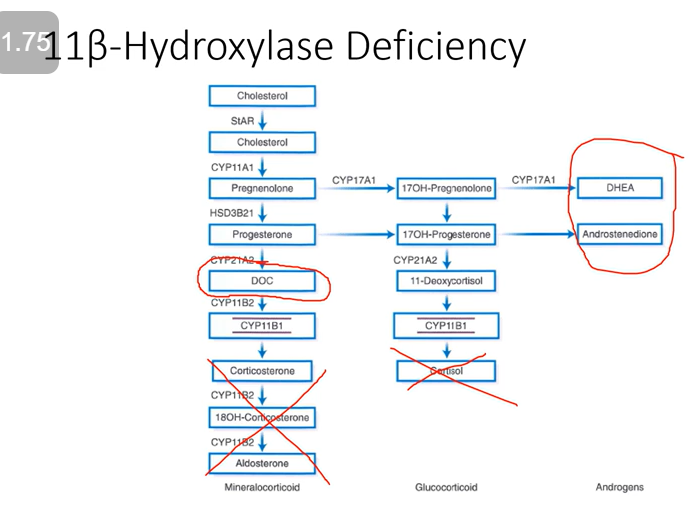
Enzyme Deficiency: 17-α-hydroxylase
Glucocorticoid Effect: Low
Mineralocorticoid Effect: Excess; hypertensive
Androgenic Effect: Low; feminizing
ACTH will be high, cortisol is gone, and we’ve lost adrenal androgens. BUT we have a build-up of DOC (thus overload of mineralocorticoids).
Caused by:
Mutation in gene CYP17
Impaired sex steroid and cortisol biosynthesis
Excess intermediary steroids with mineralocorticoid activity leads to varying degrees of hypertension and hypokalemia
No androgen activity
Females fail to develop secondary sexual characteristics
Males develop ambiguous external genitalia
